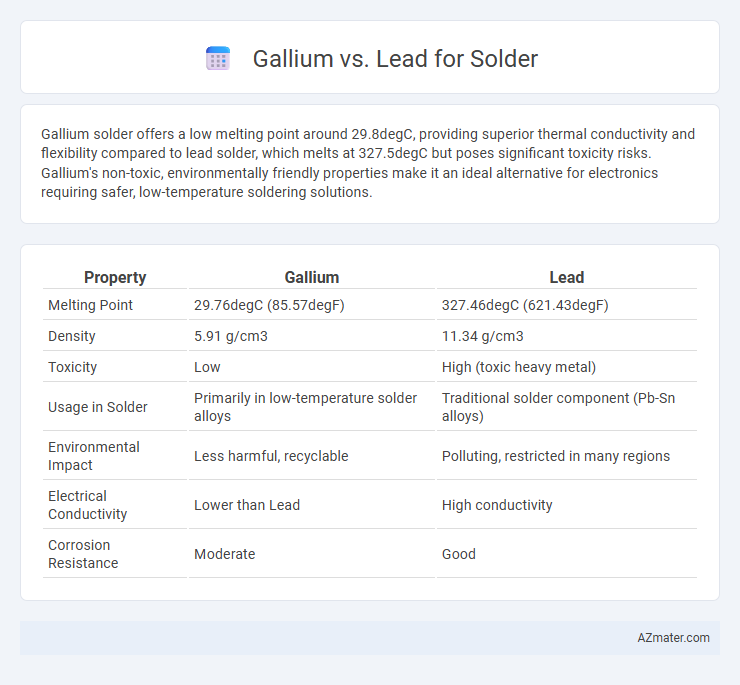Gallium solder offers a low melting point around 29.8degC, providing superior thermal conductivity and flexibility compared to lead solder, which melts at 327.5degC but poses significant toxicity risks. Gallium's non-toxic, environmentally friendly properties make it an ideal alternative for electronics requiring safer, low-temperature soldering solutions.
Table of Comparison
| Property | Gallium | Lead |
|---|---|---|
| Melting Point | 29.76degC (85.57degF) | 327.46degC (621.43degF) |
| Density | 5.91 g/cm3 | 11.34 g/cm3 |
| Toxicity | Low | High (toxic heavy metal) |
| Usage in Solder | Primarily in low-temperature solder alloys | Traditional solder component (Pb-Sn alloys) |
| Environmental Impact | Less harmful, recyclable | Polluting, restricted in many regions |
| Electrical Conductivity | Lower than Lead | High conductivity |
| Corrosion Resistance | Moderate | Good |
Introduction to Gallium and Lead in Soldering
Gallium and lead serve distinct roles in soldering due to their unique physical properties and environmental impacts. Gallium boasts a low melting point around 29.76degC, enabling solder joints with excellent thermal conductivity and flexibility, making it ideal for delicate electronic components. Lead, traditionally used for its reliable melting point near 327.5degC and strong mechanical bonds, has declined in usage due to toxicity concerns and strict environmental regulations promoting lead-free alternatives.
Chemical and Physical Properties Comparison
Gallium exhibits a low melting point of 29.76degC and expands upon solidification, unlike lead which melts at 327.46degC and contracts when solid. Chemically, gallium is less toxic, has a higher corrosion resistance, and forms stable compounds with less environmental impact compared to lead, known for its toxicity and bioaccumulative nature. Physically, gallium's brittleness and limited mechanical strength contrast with lead's excellent malleability, influencing their respective durability and application in soldering.
Melting Points: Gallium vs Lead
Gallium has a melting point of approximately 29.76degC (85.57degF), which is significantly lower than lead's melting point of 327.46degC (621.43degF). This difference makes gallium suitable for low-temperature soldering applications, while lead is preferred for traditional high-temperature soldering. The low melting point of gallium allows it to remain in liquid form near room temperature, offering unique benefits in electronics assembly.
Electrical Conductivity and Performance
Gallium exhibits significantly higher electrical conductivity compared to lead, enhancing solder joint efficiency in electronic circuits. Its low melting point and excellent wetting properties improve performance by creating strong, reliable connections with minimal thermal stress. Lead-based solder, while traditional, offers lower conductivity and raises environmental concerns, making gallium an increasingly preferred alternative in advanced electronic applications.
Health and Environmental Impacts
Gallium solder exhibits significantly lower toxicity and environmental persistence compared to lead-based solder, reducing health risks and contamination concerns in electronic manufacturing. Lead solder contains toxic heavy metals that pose neurotoxic hazards to workers and contribute to soil and water pollution when improperly disposed of. Using gallium-based alloys promotes safer recycling processes and aligns with regulations like RoHS aimed at minimizing hazardous substances in electronics.
Application Suitability and Industry Use Cases
Gallium offers low melting points around 29.8degC, making it suitable for sensitive electronics requiring low-temperature soldering applications, such as in microelectronics and flexible circuits. Lead-based solder, with a melting range of 183-190degC, remains widely used in traditional electronics manufacturing due to its excellent mechanical strength and reliable electrical conductivity, especially in automotive and aerospace industries. Emerging sectors prioritize lead-free gallium alloys for environmental compliance, while legacy systems still often depend on lead solder for durability and long-term performance.
Cost and Availability Analysis
Gallium solder offers a higher cost compared to traditional lead-based solder due to its relative scarcity and complex extraction process. Lead solder remains more affordable and widely available, benefiting from established production and supply chains. Market demand and regulatory restrictions on lead use continue to influence the pricing dynamics and accessibility of these solder materials.
Durability and Reliability in Joints
Gallium-based solder alloys exhibit superior durability in joints due to their resistance to thermal fatigue and corrosion compared to traditional lead-based solders. Lead solder, while historically reliable, tends to form brittle intermetallic compounds that reduce joint longevity under mechanical stress. The enhanced wetting properties and lower melting point of gallium alloys contribute to more reliable electrical connections and extended service life in electronic assemblies.
Regulatory and Safety Considerations
Gallium solder offers a safer alternative to lead-based solder due to its non-toxic and environmentally friendly properties, aligning with global regulations such as RoHS (Restriction of Hazardous Substances) that limit the use of lead in electronics. Lead solder poses significant health risks, including lead poisoning and environmental contamination, leading to strict regulatory restrictions and mandatory labeling requirements under agencies like OSHA and REACH. Compliance with these regulations makes gallium solder preferred in consumer electronics and medical devices, as it reduces hazardous waste and mitigates occupational exposure risks.
Future Trends in Solder Materials
Gallium is emerging as a promising alternative to traditional lead-based solder due to its low melting point, non-toxicity, and excellent wetting properties, which align with increasing environmental regulations and consumer safety demands. Advanced research is focusing on gallium alloys that enhance mechanical strength and thermal stability, addressing the brittleness issues that historically limited gallium's applications. Future trends emphasize the integration of gallium-based solders in flexible electronics and high-performance computing, driven by the need for sustainable and reliable materials in next-generation electronic manufacturing.

Infographic: Gallium vs Lead for Solder
 azmater.com
azmater.com